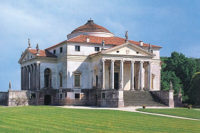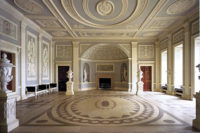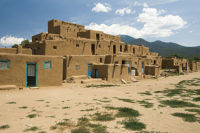The History of Plaster in Architecture: The Ancient and Classical Periods
The art of plastering is as old as civilization.






Mankind’s ability to leave the cave, raise a shelter of stones or reeds, and coat that shelter with an earthen plaster, enabled him to create the “cave” wherever he desired. Building permanent dwellings close to fresh water, upon a fortifiable position, or adjoining arable land, allowed extended families to gather, and the first cities to be born.
The very first plasters were earthen. Being simple mixtures of clay, sand and straw, they required no furnaces and dried with the sun. The mixture was cast as bricks and the same basic formula was used as the mortar and stucco. Earthen plasters such as cob and daub are still the most commonly used plasters worldwide.
Calcium plasters such as gypsum and lime were likely discovered through the process of pottery making. By chance, rocks of gypsum or lime were selected to form the crude kiln for firing pottery. The heat of the fire drove off water (gypsum) or carbon dioxide (lime) leaving friable rocks quickly falling to powder. With water thrown on the embers to quench the fire it was soon discovered this powder formed a paste that quickly hardened.
THE ANCIENT WORLD
One of the earliest archeological examples of both civilization and plaster is Çatalhöyük (ca. 7500 BC), located in present day Turkey. A densely populated town, Çatalhöyük’s dwellings had mud brick walls and floors coated with a locally available clay marl that made a suitable plaster. What little we know of this ancient civilization survives in lime frescoes, depicting numerous scenes of hunting, volcanoes and geometric patterns of purely decorative expression.
The best preserved examples of plasterwork in the pre-Classical period are found in the monumental architecture of ancient Egypt dating from the 3rd millennium BC.
Practical construction uses include the pyramids of Giza containing gypsum and lime mortars, the exteriors of which originally received smooth lime stucco. Countless surviving works of frescoes and ornament such as the renowned gypsum bust of Nefertiti attest to the parallel artistic development of plasterwork. In fact, the lime and gypsum plasters produced in Egypt were in many cases of superior quality compared to commercially available quality today. This gives testament to the fact that the empirical refinement of plaster manufacture extended many generations further back in time.
The Minoan civilization emerged in the 2nd millennium BC on the Mediterranean isle of Crete, Greece. The Minoans were greatly influenced by the still flourishing Egyptian culture as evidenced by the architecture of the palaces at Knossos and Phaistos. However, the Minoans were able to distinguish themselves by the extensive use of plaster in their interiors. In contrast to formalized Egyptian motifs typically carried out al secco, the Minoans had an exuberance of colored decoration realized al fresco. Although maintaining the profile view and stark outline typical of Egyptian art, the buon fresco techniques employed by Minoan artisans obligated a faster pace and improvisation resulting in a fluid, vibrant aesthetic.
THE CLASSICAL PERIOD
The Mycenaeans would succeed as the dominant culture of Crete and the Greek archipelago maintaining and refining the Minoan architectural style. However, as Rome would fall centuries later to the barbarians plunging Europe into a Dark Age, a similar fate befell Mycenae primarily at the hands of the Dorian and Ionian conquering tribes. During this Greek Dark Age, much of the knowledge of construction and architecture was lost for a period of centuries. Finally, in the 8th century BC, the two rival groups would join to form the Hellenes and establish a culture that left an indelible mark on human civilization.
Although the use of plaster never ceased entirely, it too would experience a renaissance in Hellenic Greece.
Thanks to the Greeks we have the English word “gypsum,” directly derived from the Greek gypsos. Similarly, it is easy to see the correlation between our word “plaster” with the Greek emplastron meaning “to daub on.” Beyond our debt of vocabulary, we owe the very foundation of our Western architectural heritage to the Greeks. The highest expression of ornament and representation of the Doric, Ionic and Corinthian Greek architectural orders to this day continues to be realized in plaster.
The Greeks were conquered militarily by the Romans in 146 BC. Yet, culturally the Romans were simultaneously enthralled by Greek culture adopting and incorporating their philosophy, architecture and art. The Romans continued the tradition of temple architecture; however, they extended their monumental architecture to include secular basilicas, imperial monuments and palatial villas. Emperor Nero’s Domus Aurea or “Golden House” and similar discoveries in Pompeii and Herculaneum are well preserved examples of how lime plastering was brought to an artistic zenith for the Roman elite. These sites offer a glimpse into a bygone era of opulence, of lavish interiors realized in fine plasterwork, entire rooms painted al fresco and barrel vaults coffered with sumptuous ornamentation in bas relief.
The Romans produced not only great artists and architects but formidable engineers. A treasure remains to us in the exhaustive architectural treatise, De Architectura, by 1st century BC Roman military engineer Marcus Polio Vitruvius. In this work commonly known as the Ten Books on Architecture, Vitruvius dedicates three chapters of Book II to the selection of sand, lime and pozzolans for stucco and concrete works. He further devotes the majority of Book VII to proper lime stucco preparation, application and fresco work.
CONCRETE
The greatest civilization of the ancient world coincided with the greatest understanding and development of plaster. The Romans expanded upon a significant discovery made by the Greeks: the additions of pozzolans to lime would create a plaster that sets in water.
Concrete was born, architectural engineering was ascendant and the Romans would go on to construct roads, aqueducts and ports that endure to this day. Roman engineering prowess and the discovery of concrete culminated in their unparalleled architectural achievement, the Pantheon. Having an interior diameter of 142 feet at its base the Pantheon remains the largest unreinforced concrete dome ever constructed.
Vitruvius treatise began to achieve widespread publication in the early 15th century. By the late 15th century there is written and archaeological evidence of Vitruvius’ hydraulic stucco recipes being utilized in Venice and Murano, 300 years before the advent of modern cement. Later we will explore how his writings together with archeological discoveries at the Domus Aurea would inspire creative geniuses such as Da Vinci, Michelangelo and Rafael to attain to dizzying heights of artistic expression in buon fresco and the modeling of stucco during the Italian Renaissance. W&C
Photo Credits - Lauri Koski - SXC, James P. Hohner Jr, & Vladimir Fofanov - SXC
Looking for a reprint of this article?
From high-res PDFs to custom plaques, order your copy today!












